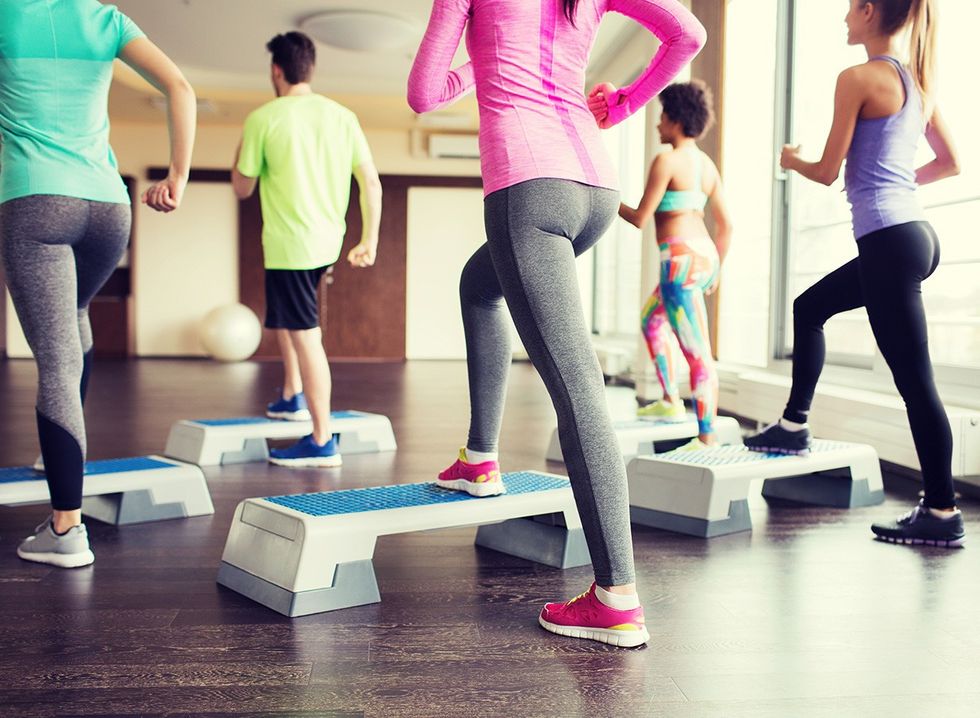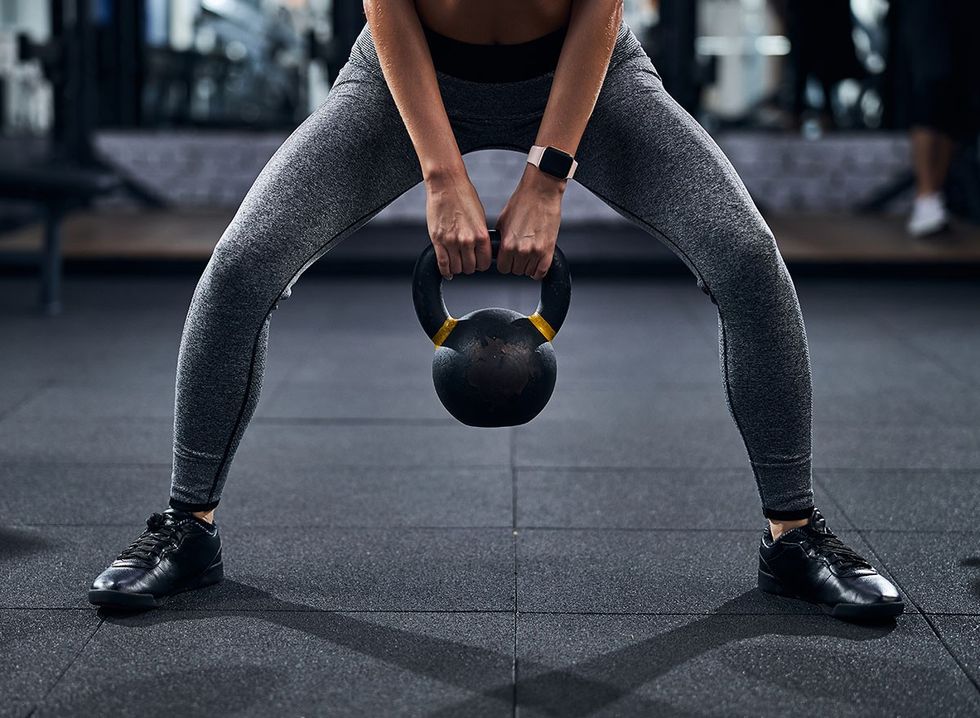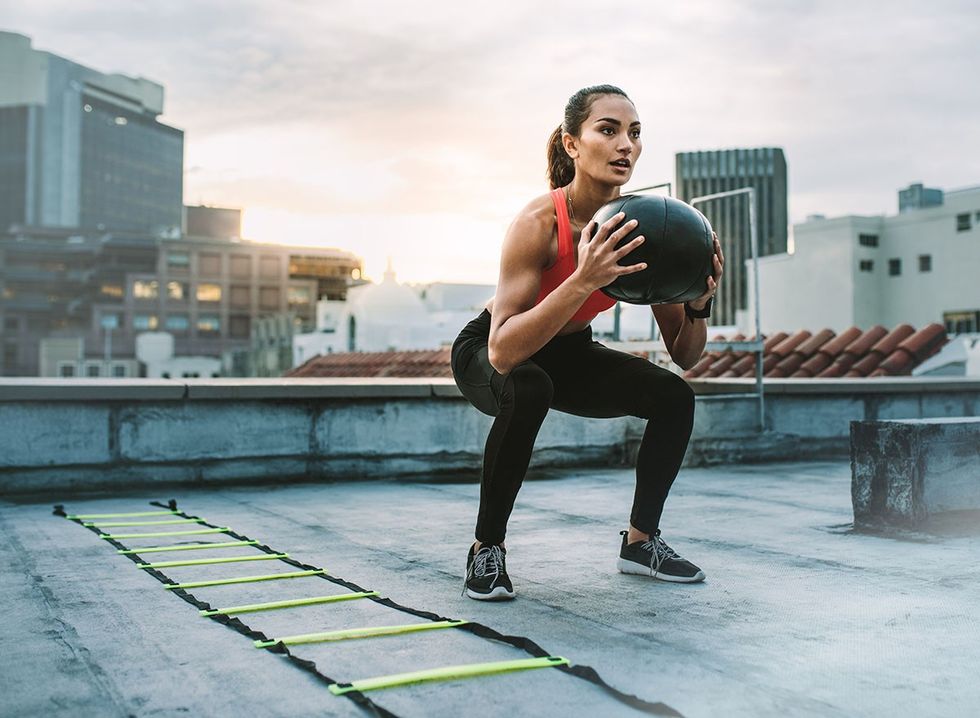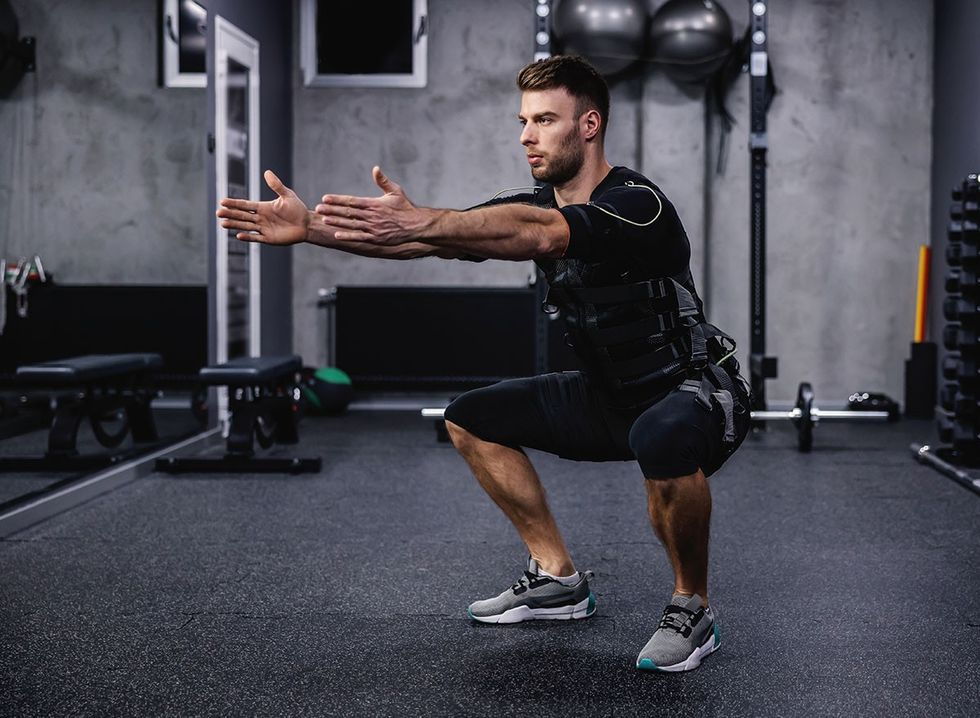As an ACE-certified trainer, I know how to get you leaner, stronger, firmer legs. The following exercises are chosen with a holistic approach to lower body training keeping strength, mobility, flexibility, and balance in mind. By improving mobility of the legs and hips, the exerciser can safely and effectively improve leg gains and strength, all while minimizing risk of injury. However, every exercise below is a strength-based leg movement. I’ve listed the exercises from simplest to complex, and the exercises with a link take you to the ACE Exercise Library and some include a demo or more detail to perform the exercise.
1. Squats

Squats- When performed with proper form, squats can be added to any fitness level routine. We perform this basic movement when we get up from a chair or couch. Therefore, how we train should also mimic how we move in our daily lives. Squats help support a strong core, glutes, hamstrings and quads. Squats can be performed assisted with a chair or bench and with or without weights. Feet are traditionally feet width apart or more with toes slightly point out so knees can effectively track as you come down to 90-degree bend or more in the knees, brace the core, and exhale as you rise back up to standing. The feet should always remain on the floor, as common incorrect movement is lifting of the heels, caving of the knees, rounding of the upper back or not going “deep” enough into the movement.
Related: 12 Best Foods For Women to Build Muscle
2. Lunges

Lunges primarily target the quadriceps, hamstrings, glutes, and calves. Additionally, they engage the core muscles for stability and balance. (a, b and c are in order of simplest to complex)
- In place- Starting with the feet hip-width apart, take a step forward with one leg, making sure to maintain a comfortable distance between your feet. Lower your body towards the ground by bending both knees simultaneously, bend the knees to a 90-degree angle, with the front knee directly above your ankle and the back knee hovering just above the ground. Push through the heel of your front foot to return to the starting position. Repeat for the desired amount of reps and then switch legs.
- Alternating Reverse lunges- With the feet about hip-width apart, slowly step backwards with one leg. After the back foot hits the ground slowly lower the back knee towards the floor and bend the front knee to a 90-degree bend. To come up, press the front foot into the ground, being to rise and bring the back leg forward to return to standing. Perform the exercise on the other leg, and alternate sides with each repetition.
- Walking lunges (or forward lunge if space is limited)- Great for balance, glute and core activation. Place feet hip-width apart and step forward with one leg. Lower the back knee almost to the floor without touching the ground. From the bottom of the movement push the front foot into the floor, brace the core and bring the back leg up and walk it forward. Perform walking lunges to the desired distance or repetitions.
3. Lateral Lunge

Lateral lunge- A lateral lunge involves a side-to-side movement that targets different muscles than traditional forward lunges such as inner and outer thigh muscles. Lateral lunges also support healthy hip mobility and flexibility. The lateral lunge mimics lateral movements that are common in daily activities, making it a functional exercise for real-life scenarios. o perform a lateral lunge, start by standing with your feet shoulder-width apart. Take a step to the side with one leg, shifting your body weight to that side. As you step, bend the knee of the lunging leg and push your hips back, keeping the opposite leg straight. Lower your body toward the bent knee, aiming for the thigh to be parallel to the ground. Push through the heel of the lunging leg to return to the starting position, bringing your feet back together.
Related: I Lost 100 Pounds Eating the Foods in My New Cookbook
4. Romanian Deadlift

Romanian Deadlift- The Romanian Deadlift is a compound exercise that primarily targets the hamstrings, glutes, and lower back. Holding a barbell or dumbbells in front of your thighs, begin by standing with your feet hip-width apart and a slight bend in your knees. Slowly hinge at the hips, pushing your glutes back rather than down, while maintaining a straight back, allowing the weights to lower towards the ground. Keep the bar or dumbbells close to your legs and then return to the starting position by extending your hips and straightening your back. This exercise helps improve hip hinge mechanics, strengthens the posterior chain, and enhances overall lower body and core stability. It is imperative that proper form is maintain, a common mistake is to round and the shoulders and not engage the shoulder blades or lat muscles.
5. Hamstring Curl

Hamstring curl- This is an isolation exercise that specifically targets the hamstrings. Typically performed using a machine, lie face down and secure your ankles under a pad. From a fully extended position, curl your legs towards your glutes by bending at the knee. Control the movement and return your legs to the starting position. Hamstring curls strengthen the muscles at the back of the thighs, aiding in knee flexion and overall leg stability. These can also be performed standing with cables.
6. Leg Adduction

Leg adduction- Is an exercise that focuses on bringing the legs together against resistance, primarily targeting the muscles of the inner thigh. Many times, inner thigh muscles are not properly trained or trained less frequently than their larger counterparts, the thighs or glutes. This movement can be performed using a dedicated leg adduction machine at the gym. Sit on the machine, adjust the settings, and bring your legs together against the resistance provided by the machine. Leg adduction exercises contribute to improved inner thigh strength and can be beneficial for overall lower body muscular balance. It is important to maintain proper core bracing and engagement to properly activate the inner thighs rather than hurt the low back.
Related: 14 Ways to Get Back in Shape
7. Bulgarian Split Squat

This a single-leg exercise that targets the quadriceps, hamstrings, and glutes. Using a bench of elevated surface, place one foot on the bench, the other foot is in alignment (knees above toes), if weighted- keep the weight at the sides or near the chest, engage the core, bend your front knee until 90 degrees or until your back knee is a couple inches from the ground. Inhale on the way down, exhale on the way up- squeeze the back upper glute and front thigh on the way up before repeating. This exercise can be performed with or without weights such dumbbells or kettlebells and supports a strong core, balance and proper muscle development of the legs.
8. Step-Ups

Step-ups- Primarily targets the quadriceps, hamstrings, and glutes. Stand in front of a sturdy platform or bench, step onto it with one foot, and then bring the opposite leg up. Step back down and alternate legs. This exercise helps improve lower body strength, stability, and can be easily modified by adjusting the height of the platform. Step-ups can be performed with or without weights and improve core strength and balance.
9. Box Jumps

Box jumps - Box jumps enhance lower body power and strength. Box jumps involve jumping onto a box or platform. Box jumps engage quadriceps, hamstrings, and glutes, improving athletic performance, agility, and cardiovascular fitness. When performing box jumps, ensure a stable landing on the box to minimize impact on the joints. With feet hip-width, hinge at your hips, bend your knees, and explosively jump onto the box. Land with both feet on the box, ensuring a stable and controlled landing, then step back down.
10. Jump Squats

Jump squats- Jump squats involve explosive jumps during a squatting motion. Start in a squat position, then explosively jump upward while extending your arms. Land softly and immediately go into the next jump squat. This plyometric exercise targets the lower body muscles, improves power, and enhances overall athletic performance.
11. Single Leg Deadlift

This unilateral exercise targets the hamstrings, glutes, and core. Stand on one leg while hinging at the hips, lowering your torso toward the ground while lifting the opposite leg behind you for balance. Return to the starting position and repeat on the same leg. Single-leg deadlifts help improve stability and balance and isolate the posterior chain muscles, contributing to overall lower body strength and flexibility.















 em_fitx/TikTok
em_fitx/TikTok em_fitx/TikTok
em_fitx/TikTok em_fitx/TikTok
em_fitx/TikTok em_fitx/TikTok
em_fitx/TikTok em_fitx/TikTok
em_fitx/TikTok em_fitx/TikTok
em_fitx/TikTok em_fitx/TikTok
em_fitx/TikTok

 Shutterstock
Shutterstock Shutterstock
Shutterstock Shutterstock
Shutterstock Shutterstock
Shutterstock Shutterstock
Shutterstock Shutterstock
Shutterstock Shutterstock
Shutterstock Shutterstock
Shutterstock Shutterstock
Shutterstock Shutterstock
Shutterstock
 Shutterstock
Shutterstock Shutterstock
Shutterstock Shutterstock
Shutterstock Shutterstock
Shutterstock


 I'm a Nutritionist and These 9 High-Protein Snacks Keep My Clients Full While Losing 50 Pounds
I'm a Nutritionist and These 9 High-Protein Snacks Keep My Clients Full While Losing 50 Pounds
 Shutterstock
Shutterstock 2. Processed FoodsShutterstock
2. Processed FoodsShutterstock Shutterstock
Shutterstock Shutterstock/Prostock-studio
Shutterstock/Prostock-studio Shutterstock
Shutterstock Pro TipsShutterstock
Pro TipsShutterstock Shutterstock
Shutterstock Shutterstock
Shutterstock Shutterstock
Shutterstock Shutterstock
Shutterstock Don’t Drink as Much AlcoholShutterstock
Don’t Drink as Much AlcoholShutterstock Most Women on GLP-1s Are Making a Few Common MistakesShutterstock
Most Women on GLP-1s Are Making a Few Common MistakesShutterstock Soda and Sugary DrinksShutterstock
Soda and Sugary DrinksShutterstock Shutterstock
Shutterstock Eat BreakfastShutterstock
Eat BreakfastShutterstock And Improve Insulin SensitivityShutterstock
And Improve Insulin SensitivityShutterstock Belly Flab Strip Tip: Sugar and Fat Calories Leave Its Mark on Your BodyShutterstock
Belly Flab Strip Tip: Sugar and Fat Calories Leave Its Mark on Your BodyShutterstock Shutterstock
Shutterstock The Drugs Mimic the GLP-1 Hormone Naturally Produced by the BodyShutterstock
The Drugs Mimic the GLP-1 Hormone Naturally Produced by the BodyShutterstock 3. Deep-Fried ItemsShutterstock
3. Deep-Fried ItemsShutterstock